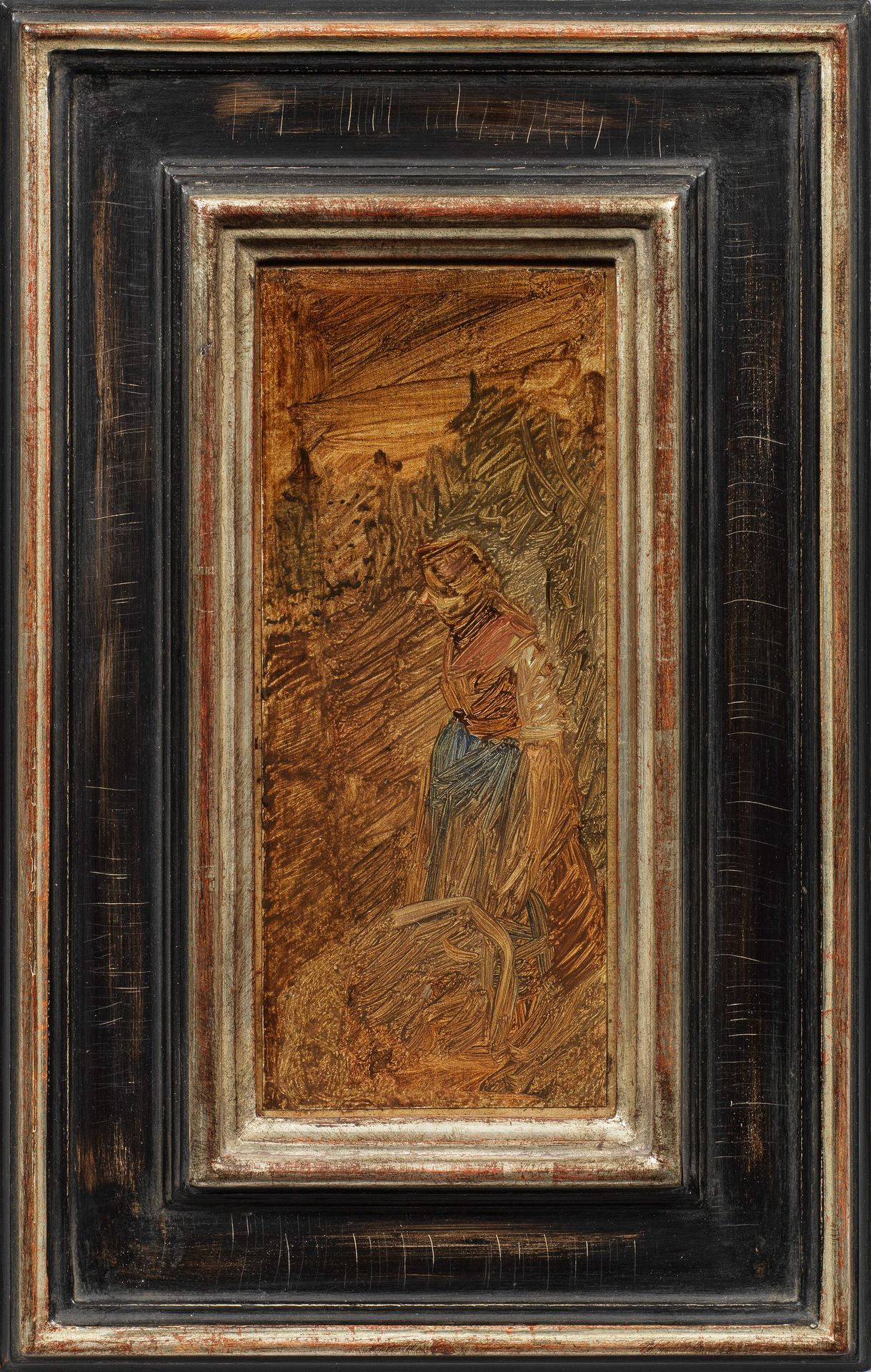Description
Wilhelm Busch (1832 Wiedensahl - 1908 Mechtshausen) Farmer's wife with red scarf Busch has captured the farmer's wife at an outdoor activity with a dense weave of lines, her clothing with blue and red color accents standing out from the otherwise tonal coloring. Like almost all of Busch's paintings, it is small-format and, with its deliberate lack of detail, is entirely focused on the overall mood. The painting was created around 1885-1890 during Busch's most important and productive creative phase as a painter. In 1872, Busch had returned to his birthplace, the village of Wiedensahl in Lower Saxony. His main subjects were immediately recognizable rural motifs from his surroundings, in addition to landscapes, especially cows, farmers, everyday scenes and the so-called "redcoats". The Dutch-Flemish painting of the 17th century, which Busch must have literally absorbed during his art studies from 1851-1853 at the art academies in Düsseldorf and Antwerp and which had a profound influence on him throughout his life, stands in the background. Oil/velino, mounted on card. Confirmation of authenticity on verso by the artist's nephew Hermann Nöldeke "I received this painting from Wilhelm Busch as having been painted by him. Hattorf a. Harz, 1.10.1928". 20.3 x 8.4 cm. Frame. Wvz. Gmelin 155. Provenance: Hermann Nöldeke, nephew of the artist (1860 - 1932), Hattorf am Harz; by inheritance to his descendant Anna Nordhausen, Herzberg; Auktionshaus Stahl, Hamburg, 18.02.2012, lot 30; privately owned, Westphalia. Oil on wove paper, laid down on cardboard. Handwritten certificate of authenticity by the artist's nephew Hermann Nöldeke (dated 1928) on the reverse. Mentioned in the catalogue raisonné no. 155.
1744
Wilhelm Busch (1832 Wiedensahl - 1908 Mechtshausen) Farmer's wife with red scarf Busch has captured the farmer's wife at an outdoor activity with a dense weave of lines, her clothing with blue and red color accents standing out from the otherwise tonal coloring. Like almost all of Busch's paintings, it is small-format and, with its deliberate lack of detail, is entirely focused on the overall mood. The painting was created around 1885-1890 during Busch's most important and productive creative phase as a painter. In 1872, Busch had returned to his birthplace, the village of Wiedensahl in Lower Saxony. His main subjects were immediately recognizable rural motifs from his surroundings, in addition to landscapes, especially cows, farmers, everyday scenes and the so-called "redcoats". The Dutch-Flemish painting of the 17th century, which Busch must have literally absorbed during his art studies from 1851-1853 at the art academies in Düsseldorf and Antwerp and which had a profound influence on him throughout his life, stands in the background. Oil/velino, mounted on card. Confirmation of authenticity on verso by the artist's nephew Hermann Nöldeke "I received this painting from Wilhelm Busch as having been painted by him. Hattorf a. Harz, 1.10.1928". 20.3 x 8.4 cm. Frame. Wvz. Gmelin 155. Provenance: Hermann Nöldeke, nephew of the artist (1860 - 1932), Hattorf am Harz; by inheritance to his descendant Anna Nordhausen, Herzberg; Auktionshaus Stahl, Hamburg, 18.02.2012, lot 30; privately owned, Westphalia. Oil on wove paper, laid down on cardboard. Handwritten certificate of authenticity by the artist's nephew Hermann Nöldeke (dated 1928) on the reverse. Mentioned in the catalogue raisonné no. 155.
